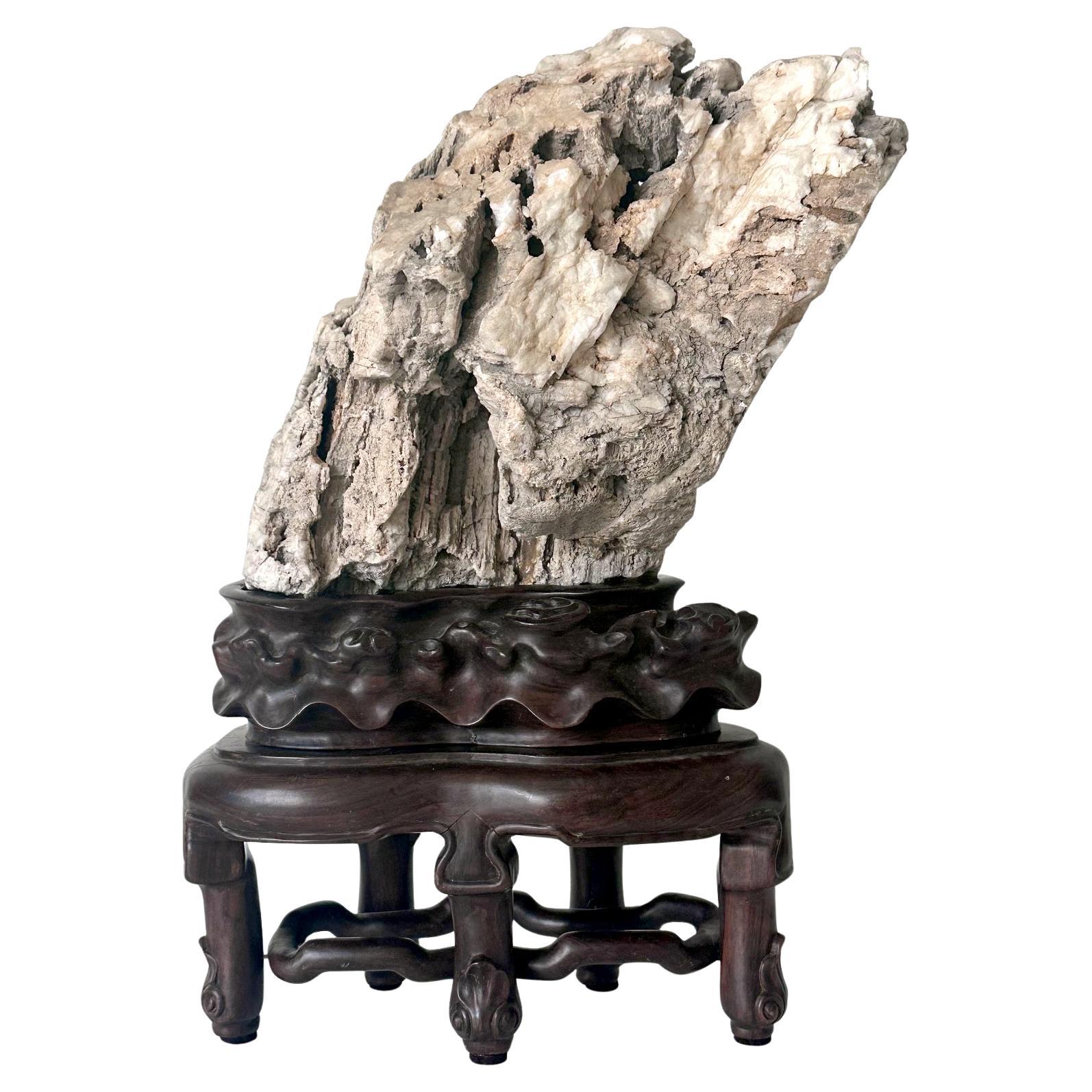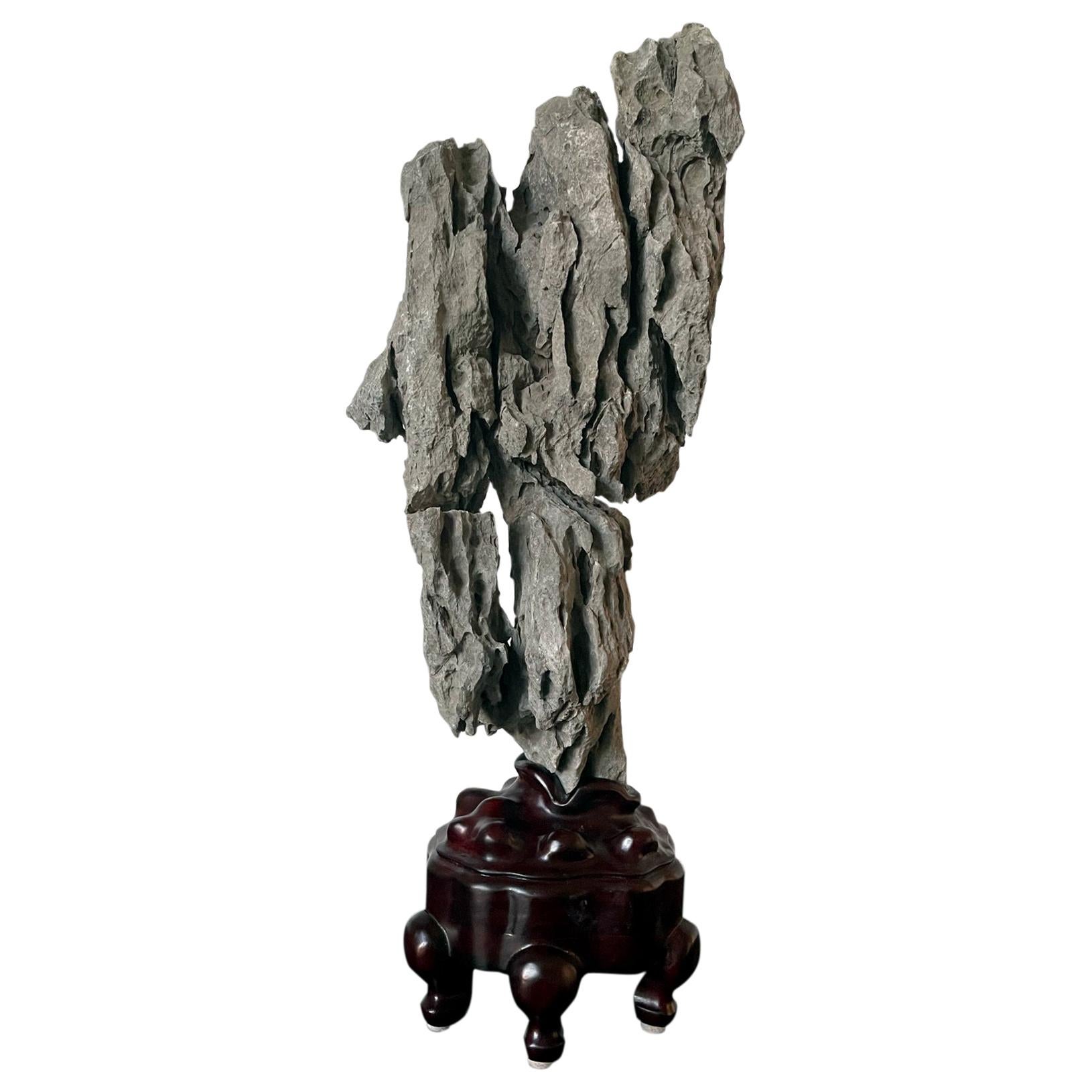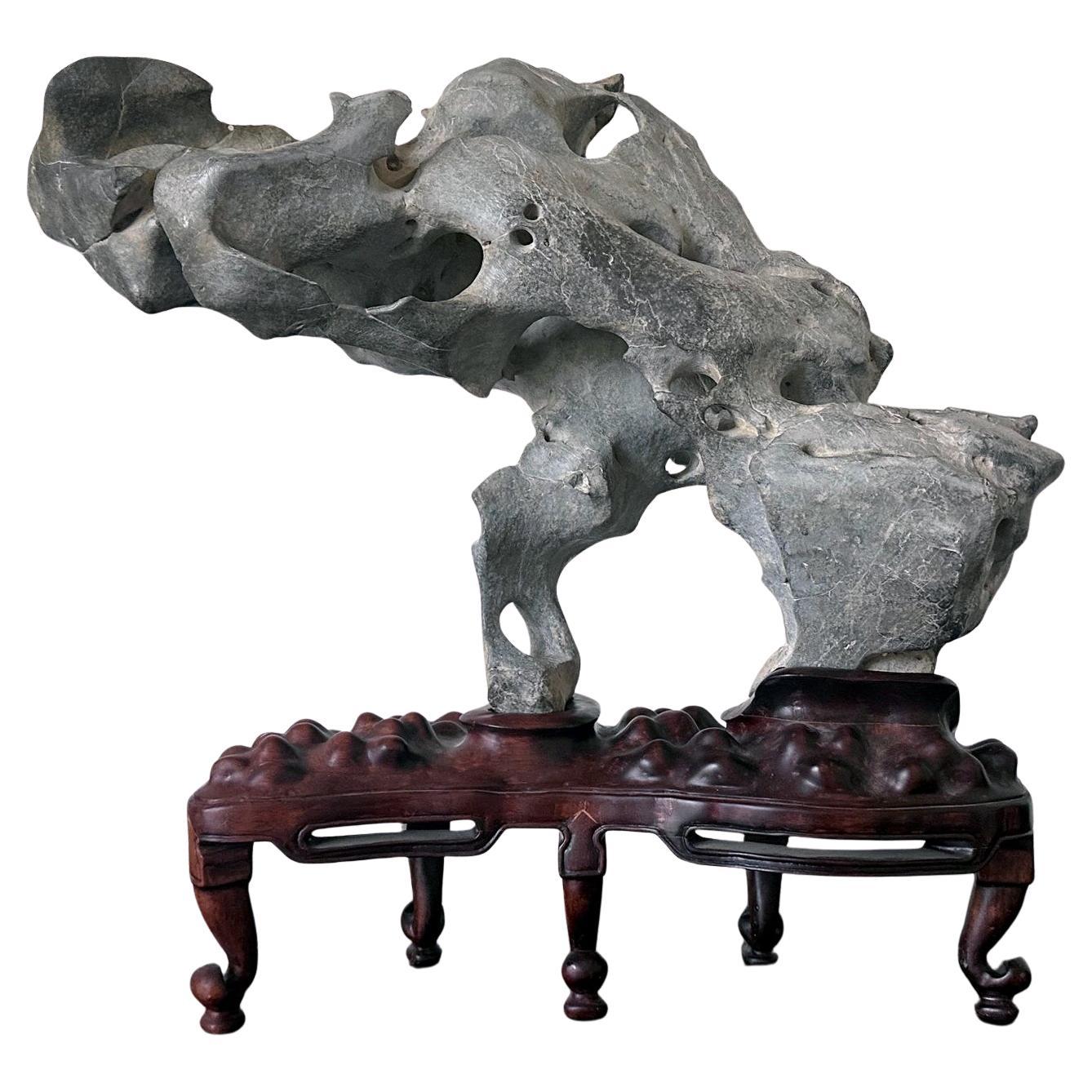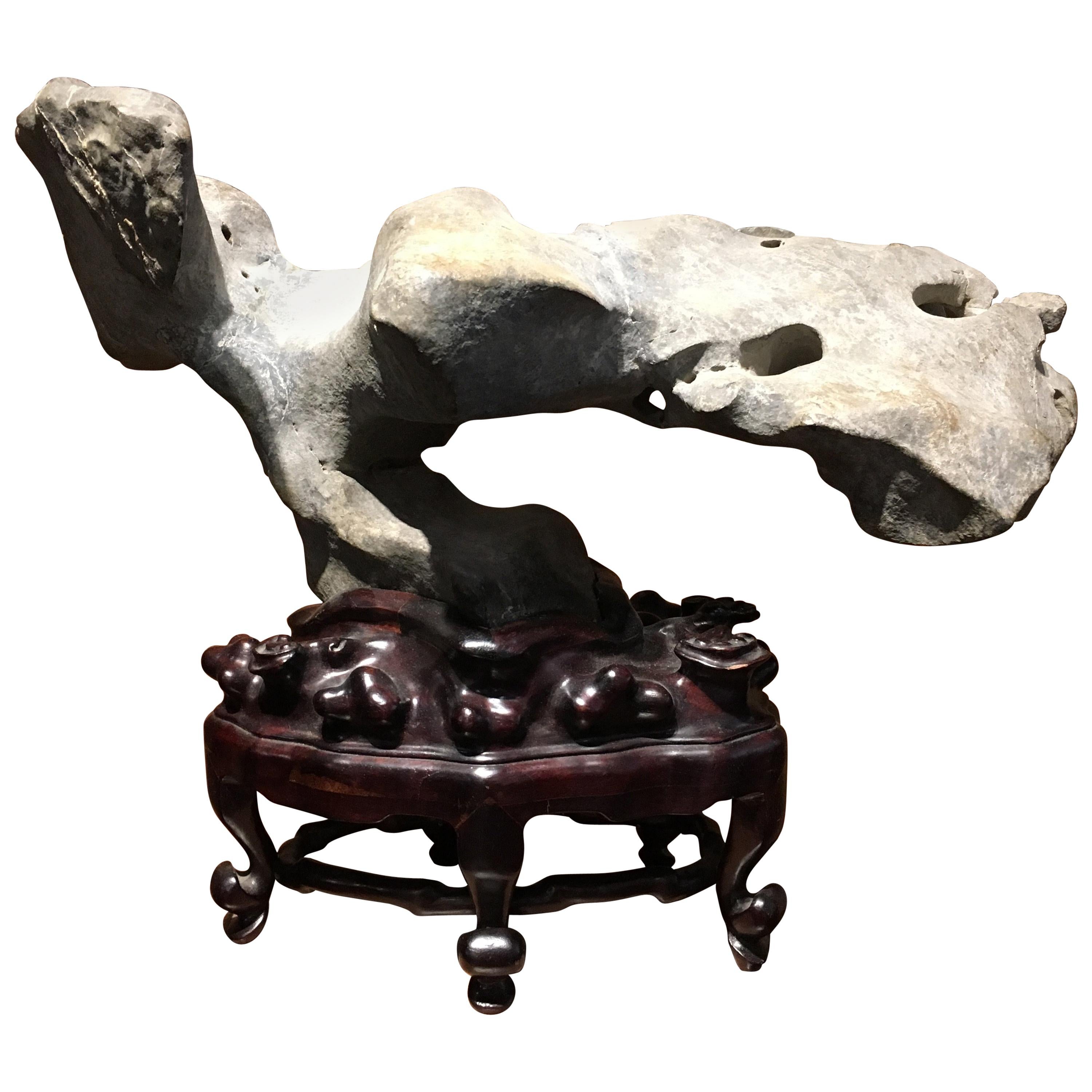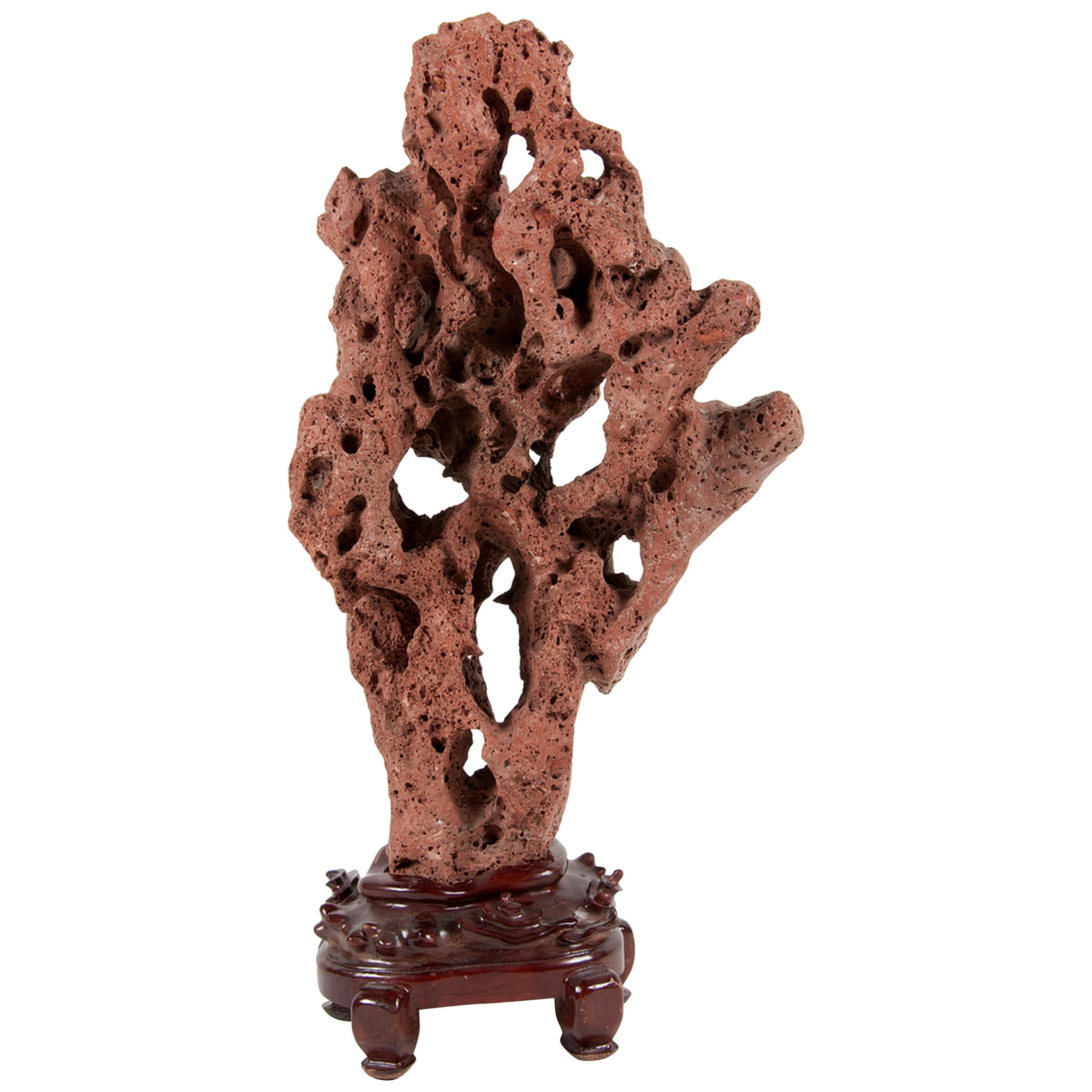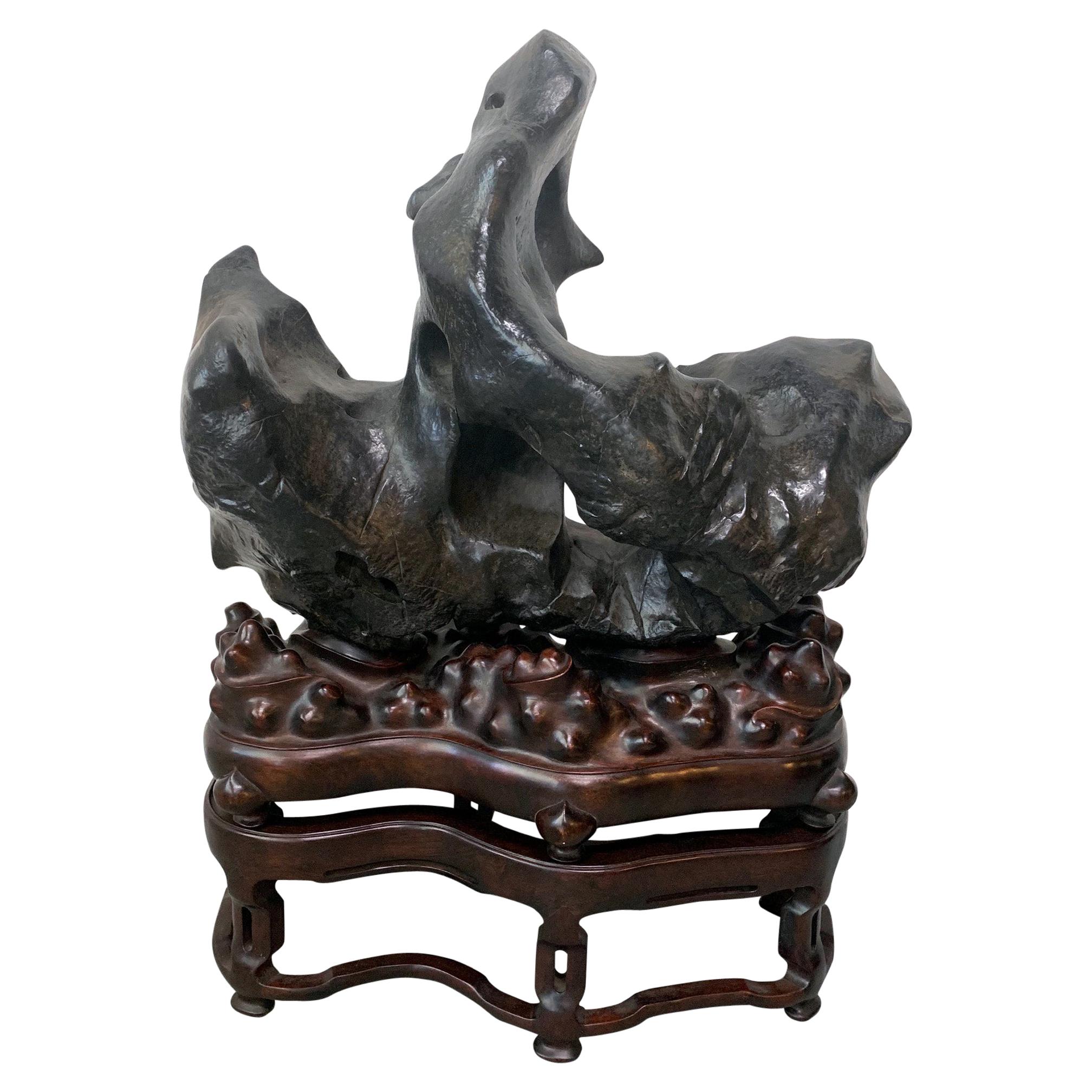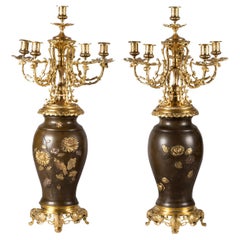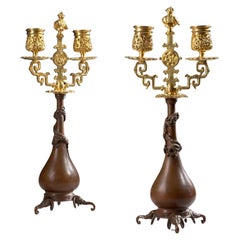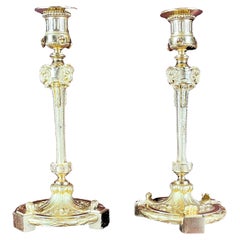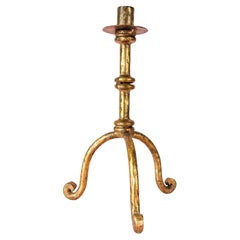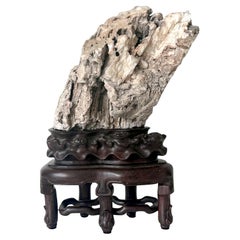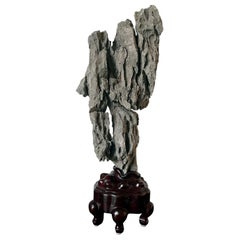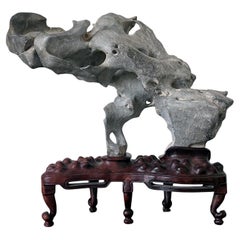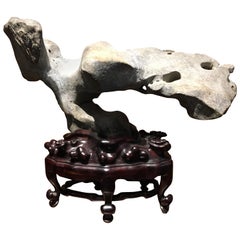Articles similaires à Scholar's Stone / “Scholar's Rock” Lingbi (灵璧石), China, Qing Dynasty
Vous voulez plus d'images ou de vidéos ?
Demander au vendeur plus d'images ou de vidéos
1 sur 21
Scholar's Stone / “Scholar's Rock” Lingbi (灵璧石), China, Qing Dynasty
18 900 €TVA incluse
À propos de cet article
An exceptional scholar's rock lingbi (灵璧石), traditionally intended for Chinese scholars, on a very elaborate Qing period wooden base. It is presented with the larger end above the smaller, a position known in China as yun tou, yu jiao or 'head in the clouds, feet in the rain', evoking an auspicious rising cloud of smoke. Its particular shape allows it to be observed both from the front and from the side.
The lingbi stone, a dark gray/black lustrous veined with white, is particularly comparable to a copy sold by Christies' in 2015 in Hong Kong (lot 3005, sale of December 2, 2015).
Dimensions: 56 cm high by 28 cm wide (the stone itself is 38 cm high).
Gongshi (Chinese: 供石), also called scholar's stones or observation stones, are natural or shaped rocks, traditionally appreciated by Chinese scholars and displayed in their workshops.
As early as the Neolithic period, nearly 7,000 years ago, stones of this type have been discovered buried in tombs. However, it wasn't until the late Tang Dynasty (618-907) that scholarly stones became a truly collectible item. Their influence on Chinese literature began to be felt a little later: "Mi Fu (1051-1107) and others composed essays on stones," explains Christie's specialist Pola Antebi, "and Du Wan (12th century) compiled the first comprehensive catalog of stones, 'Yunlin shipu,' testifying to the growing appreciation of these stones."
As early as the Song Dynasty, naturally eroded stones were collected and displayed for viewing. By the 17th century, some stones were considered important and respected enough to be the subject of portraits. In his mid-19th-century work, Tanshi (Conversations on Rocks), Liang Jiutu argued that "in collecting, it is the choice of stones that is paramount." If the stone does not resemble a painting created by the forces of nature, it should not be chosen."
During the Tang dynasty, four important qualities were recognized for stones: fineness (瘦 shòu), openness (透 tòu), perforations (漏 lòu), and wrinkling (皺 zhòu). With these qualities, the observer can admire the strength of the contours, perhaps seeing a mountain ridge or a cloud rising within the amorphous mass. The stone can be displayed on a specially carved rosewood base. Scholar's stones are a traditional subject of Chinese painting.
Rocks are classified according to their origin. The most venerated sites are (i) the Lingbi Stone (Lingbishi) (灵璧石) of Lingbi, Anhui Province, (ii) the Taihu Stone (Taihushi) (太湖石) of Lake Tai, Jiangsu Province, and (iii) the Yingde Stone (Yingshi or Yingdeshi) (英石 or 英德石) of Yingde, Guangdong Province. Besides small table specimens, many monumental boulders are found in gardens throughout China, including the "auspicious cloud peak" in the Lingering Garden in Suzhou.
Robert D. Mowry, a distinguished expert and curator emeritus of the Harvard Art Museum, describes them as "stones prized by Chinese scholars, displayed in the rarefied atmosphere of their studios." The Chinese scholar drew his inspiration from nature; He didn't venture into nature to paint or compose poems, explains Christie's specialist Pola Antebi. Instead, he worked in the privacy of his studio and drew inspiration from these "mountain depictions."
The stones were often brought to scholars from remote areas, with the finest coming from riverbeds or mountains. Some of the most valuable examples came from Lingbi, in Anhui Province, northern China. "Because of their density, Lingbi stones are naturally resonant," explains Mowry. "The best Lingbi stones are deep black; often slightly textured, their surfaces appear wet and shiny."
- Dimensions:Hauteur : 56 cm (22,05 po)Largeur : 28 cm (11,03 po)Profondeur : 20 cm (7,88 po)
- Style:Qing (De la période)
- Matériaux et techniques:
- Lieu d'origine:
- Période:
- Date de fabrication:1850-1911
- État:Usure conforme à l'âge et à l'utilisation.
- Adresse du vendeur:MOUGINS, FR
- Numéro de référence:1stDibs : LU10660247021602
À propos du vendeur
Nouveau sur 1stDibs
Inscrit au cours des six derniers mois.
Aucune évaluation pour le moment
Vendeur professionnel agréé
Chaque vendeur répond à des normes strictes en matière d'authenticité et de fiabilité
Vendeur 1stDibs depuis 2025
- ExpéditionRecherche du devis...Expédition depuis : MOUGINS, France
- Politique des retours
Certaines parties de cette page ont été traduites automatiquement. 1stDibs ne garantit pas l'exactitude des traductions. L'anglais est la langue par défaut de ce site web.
Garantie d'authenticité
Bien qu'il soit peu probable que la situation se présente, dans le cas où vous rencontreriez un problème d'authenticité d'un article, contactez-nous dans un délai d'un an pour obtenir un remboursement intégral. DétailsGarantie de remboursement
Si votre article n'est pas conforme à la description, est endommagé pendant le transport ou ne vous est pas livré, contactez-nous sous 7 jours pour obtenir un remboursement intégral. DétailsAnnulation sous 24 heures
Vous disposez d'un délai de 24 heures pour annuler votre achat sans motif.Des vendeurs professionnels agréés
Nos vendeurs de renommée mondiale doivent respecter des normes strictes en matière de service et de qualité, afin de préserver l'intégrité de nos fiches produit.Garantie d'alignement des prix
Si vous constatez qu'un autre vendeur a mis en vente le même article à un prix inférieur sur un autre site, nous nous alignerons sur ce prix.Livraison en toute confiance à l'international
Notre réseau de transporteurs de premier ordre propose des options d'expédition spécialisées dans le monde entier, y compris des livraisons personnalisées.Plus d'articles de ce vendeur
Tout afficherPair Of Aesthetic/Japonism Style Candelabras - Meiji with Shakudo Decoration
A beautiful and very large pair of Meiji period Japanese bronze vases with brown patina and caved design with applied gilt and silver bronze inserts representing birds and insects fl...
Catégorie
Antiquités, Fin du XIXe siècle, Français, Japonisme, Candélabres
Matériaux
Bronze
Pair of Japanese-style Candlesticks by Ferdinand Barbedienne and Edouard Lievre.
Par Ferdinand Barbedienne, Edouard Lievre
Exceptional pair of candlesticks with ovoid body and domed belly in chiseled bronze with brown patina on which a dragon coils, resting on tripod bases with 3 stylized elephant heads ...
Catégorie
Antiquités, Fin du XIXe siècle, Français, Japonisme, Candélabres
Matériaux
Bronze
Maison Marnyhac - Pair Of Candlesticks - Gilt & Chiseled Bronze - 19th Century
Par Maison Marnyhac 1
A rare pair of candle-holders in chiseled and gilt bronze in Louis XVI / 18th century style, signed by Maison Marnyhac and manufactured in the late 19th century.
Rich ornamentation ...
Catégorie
Antiquités, Fin du XIXe siècle, Français, Louis XVI, Bougeoirs
Matériaux
Bronze
Brutalist Candleholder - Gilt & Patinated Bronze - 1950s
A candle-holder in wrought iron. It is plated with gold leaf and patinated, resting on three curved feet.
This piece is in Brutalist style and was manufactured in the 1950s. It comp...
Catégorie
Vintage, années 1950, Français, Brutalisme, Bougeoirs
Matériaux
Bronze
Pierre Casenove for Fondica - Gilt Bronze High Table Lamp - 1980s
Par Pierre Casenove
A high table lamp in gilt bronze with its original shade and in perfect condition, resting on four feet.
Signed on one foot by Pierre Casenove and on another by Fondica, as well as ...
Catégorie
Vintage, années 1980, Français, Lampes de bureau
Matériaux
Bronze
Roger Capron - Rare Wall Flower Vase
Par Roger Capron
A rare wall flower vase by Roger Capron (1922-2006) in white ceramic with patterned design created using paraffin during the glazing process, as well as a black / yellow painted patt...
Catégorie
Vintage, années 1960, Français, Vases
Matériaux
Céramique
Suggestions
Rare pierre chinoise Xuan Scholar sur Stand
Rare pierre de lettré chinois de type Xuan sur un socle en bois sculpté, vers le XIXe siècle, dynastie Qing. La pierre de Xuan est traditionnellement collectée à Xuan Zhou, dans la p...
Catégorie
Antiquités, XIXe siècle, Chinois, Qing, Objets pour érudits
Matériaux
Pierre
Extraordinaire pierre Ying de Chine sur Stand
La pierre de lettré chinoise proposée ici est un magnifique exemple de Ying (également connue sous le nom de pierre de Yingde), un type moins courant que le Lingbi ou le Taihu. De co...
Catégorie
Antiquités, XIXe siècle, Chinois, Qing, Objets pour érudits
Matériaux
Pierre
Extraordinaire pierre chinoise Taihu Scholar Rare Form on Display Stand
Une étonnante pierre de savant de Taihu dans une forme horizontale équilibrée inhabituelle, perchée sur un support en bois personnalisé. La pierre, d'un blanc grisâtre presque pur, p...
Catégorie
Antiquités, XIXe siècle, Chinois, Qing, Objets pour érudits
Matériaux
Pierre
Pierre d'érudit chinoise Lingbi grise, début du 20e siècle
Une fantastique pierre d'érudit chinoise, appelée gongshi, en calcaire gris lingbi, montée sur un support en bois dur, fin Qing ou début de la République, début du 20e siècle.
La p...
Catégorie
Début du 20ème siècle, Chinois, Qing, Objets pour érudits
Matériaux
Calcaire
Grande pierre d'érudit chinoise Rare pierre de Taihu rouge sur Stand d'exposition
Un grand et spectaculaire Gongshi chinois (connu sous le nom de pierre de méditation ou de pierre spirituelle) de Taihu (lac Tai) en équilibre sur un présentoir. Cette roche savante ...
Catégorie
Antiquités, XIXe siècle, Chinois, Exportation chinoise, Objets pour érudits
Matériaux
Pierre
Grande pierre chinoise spectaculaire Lingbi Scholar Stone sur Stand
L'une des plus belles pierres chinoises (également connues sous le nom de Gong Shi, pierre de méditation et pierre spirituelle) que nous ayons jamais proposées. Un bloc massif de merveilles formées naturellement, présenté sur un support en bois à deux niveaux, datant de la dynastie Qing, 19e siècle. La pierre de Lingbi présente une surface noire presque complète qui a été parfaitement altérée par les éléments pendant des millénaires. Lisse en général, la surface est ponctuée de rides, de sillons et de plis spectaculaires et présente de nombreuses grottes interconnectées. La formation poétique suggère une chaîne de montagnes à trois pics avec des grottes internes. C'est un plaisir visuel de méditer sur ce rocher. Les pierres de Lingbi...
Catégorie
Antiquités, XIXe siècle, Chinois, Chinoiseries, Objets pour érudits
Matériaux
Pierre
